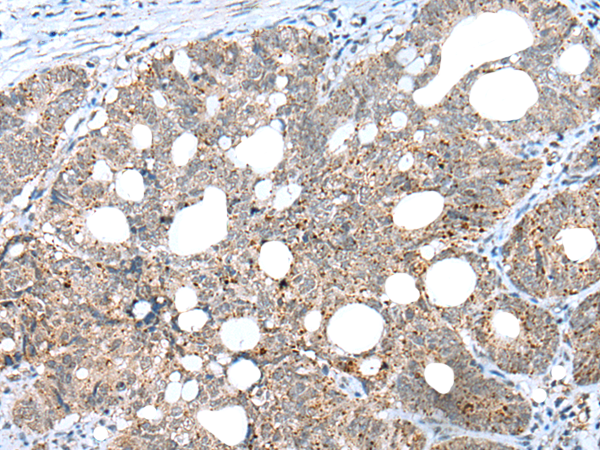
| WB | 咨询技术 | Human,Mouse,Rat |
| IF | 咨询技术 | Human,Mouse,Rat |
| IHC | 1/25-1/100 | Human,Mouse,Rat |
| ICC | 技术咨询 | Human,Mouse,Rat |
| FCM | 咨询技术 | Human,Mouse,Rat |
| Elisa | 1/5000-1/10000 | Human,Mouse,Rat |
| Aliases | CD299; LSIGN; CD209L; L-SIGN; DCSIGNR; HP10347; DC-SIGN2; DC-SIGNR |
| Host/Isotype | Rabbit IgG |
| Antibody Type | Primary antibody |
| Storage | Store at 4°C short term. Aliquot and store at -20°C long term. Avoid freeze/thaw cycles. |
| Species Reactivity | Human |
| Immunogen | Synthetic peptide of human CLEC4M |
| Formulation | Purified antibody in PBS with 0.05% sodium azide and 50% glycerol. |
+ +
以下是关于CLEC4M抗体的3篇参考文献的简要总结:
---
1. **文献名称**:*CLEC4M is a human glycoprotein receptor for hepatitis C virus*
**作者**:Gardner, J.P. et al.
**摘要**:研究揭示了CLEC4M(L-SIGN)作为丙型肝炎病毒(HCV)的功能性受体,通过抗体阻断实验证明CLEC4M抗体可抑制HCV假病毒颗粒的细胞结合,表明其在病毒入侵中的关键作用。
---
2. **文献名称**:*L-SIGN (CLEC4M) mediates HIV-1 trans-infection and antibody-dependent enhancement of viral infection in dendritic cells*
**作者**:Turville, S.G. et al.
**摘要**:研究发现CLEC4M通过树突状细胞介导HIV-1的跨感染,使用特异性抗体阻断CLEC4M可显著减少病毒传播,提示其在HIV免疫逃逸中的潜在治疗靶点。
---
3. **文献名称**:*CLEC4M binds SARS-CoV-2 spike protein to enhance viral entry and risk of COVID-19 severity*
**作者**:Zhang, Y. et al.
**摘要**:该文献证实CLEC4M通过与SARS-CoV-2刺突蛋白结合促进病毒进入宿主细胞,利用CLEC4M中和抗体可降低感染效率,为COVID-19的抗体治疗提供了实验依据。
---
如需获取完整文献,建议通过PubMed或Google Scholar搜索上述标题及作者。
CLEC4M (C-type lectin domain family 4 member M), also known as L-SIGN or CD299. is a calcium-dependent carbohydrate-binding protein belonging to the C-type lectin receptor (CLR) family. Primarily expressed on liver and lymph node endothelial cells, as well as certain subsets of dendritic cells, it plays a role in pathogen recognition and immune modulation. Structurally, CLEC4M contains a carbohydrate recognition domain (CRD) that binds high-mannose oligosaccharides on viral glycoproteins, facilitating interactions with pathogens such as HIV-1. HCV, SARS-CoV, and Ebola virus. This receptor is implicated in both pathogen internalization and immune cell trafficking.
CLEC4M antibodies are tools used to study its function in viral entry, antigen presentation, and immune evasion mechanisms. Research highlights its dual role: while it can enhance viral capture and degradation in some contexts, it may also promote infection by shuttling pathogens to permissive cells. Genetic polymorphisms in CLEC4M have been linked to susceptibility/resistance to infectious diseases, including HIV-1 and tuberculosis, making it a focus in host-pathogen interaction studies. Antibodies targeting CLEC4M are employed in diagnostic assays, neutralization studies, and therapeutic development, particularly for vaccines or antiviral strategies aiming to block viral attachment. Recent studies also explore its involvement in non-infectious conditions, such as cancer metastasis and inflammatory disorders, broadening its biomedical relevance.
×